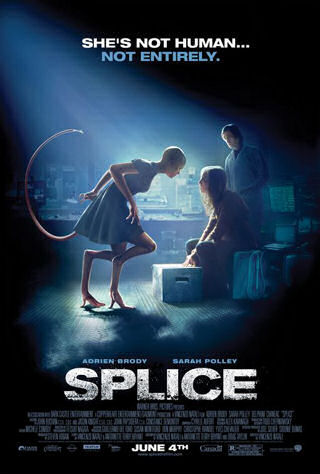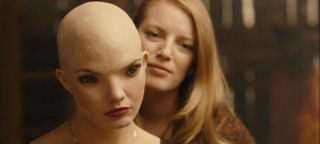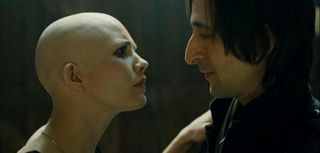|
Splice
We
already know that there are few original sci-fi or horror
films being made. So much ground has been covered in either
genre over the years that coming up with any new angle can
prove to be quite the challenge. Yet last year, exceptions
like Moon, District
9 and Pandorum
delivered a fresh look at some familiar conventions of the
sci-fi/horror genre without the label of remakes, prequels
or sequels slapped on them.
Splice
is another film of that genre that steers clear of such
labels as it made its way around the festival circuit last
fall before making it to Sundance this past January. It
clearly has early David Cronenberg and Hammer Horror influences,
but for all its ambition can’t quite compare to those
other three films.
The
story involves two scientists and lovers, Clive (Adrien
Brody) and Elsa (Sarah Polley), who have reached a certain
level of fame in their field. At their research lab, Nucleic
Exchange Research and Development, or N.E.R.D., they’ve
created freaky, slug-like hybrids named Fred and Ginger,
by splicing animal DNA. The corporation that owns N.E.R.D
see these two creatures as a goldmine opportunity, using
their proteins as potential cures for various diseases.
Now, we know from previous mad scientist-type films that
it’s never about money and always about that temptation
to follow through with that forbidden “breakthrough”.
In this case, that would be combining human and animal DNA
for a roll-of-the-dice result.
Invoking
Biblical Eve, impetuous Elsa takes that extra step toward
god-like power and, in a move unbeknownst to Clive, has
a human ovum readied for splicing. After initial protest
from Clive, the two agree to embark on their covert artificial
birth and soon enough….their “child” is
born. Elsa is the first to encounter this little mole rat-looking
science freak with a penchant for tic-tacs.
The
winged creature soon grows into toddler sized (played by
Abigail Chu) and she and Elsa develop a creepy yet cute
bond. Elsa names her Dren and comes to see her as less of
a project and more of an offspring, as Clive cautiously
witnesses. She can spell out words yet her communication
is limited to a variety of chirps, whistles and howls. Like
any child, Dren lashes out in tantrums when she is frustrated,
so play nice or you’ll meet the business end of her
tail.
Dren
grows exponentially, making it difficult for the two geneticists
to conceal her existence from their superiors. Elsa also
grows exponentially, protective that is, while Clive grows
increasingly unsure with her intentions. Meanwhile, Dren
has breezed past puberty and has now become a most curious
young, er, woman (played superbly by Delphine Chaneac).
Watch out for any hormonal imbalance since Dren can lash
out with her superior strength and animal instinct.
Once
Dren is moved into an old country barn where Elsa grew up
she starts acting out against her maternal creator and is
drawn uncomfortably closer to Clive. She develops an awareness
on many levels, coming to understand the limits she has
been given, her violent potential, and an inevitable sense
of sensual discovery. Clearly, Clive and Elsa had no clue
what they would be creating, much less experiencing.
A film
like this relies heavily on how believable the creature
is, both visually and in characterization. This is where
the film really succeeds. There’s some top-notch talent
in the CGI department bringing to life a creature that seamlessly
interacts with humans and the environment around it. Natali
and special effects makeup artists Greg Nicotero and Howard
Berger carefully balance Dren’s introduction to the
audience by creating mystery and empathy for the character
despite its deadly tendencies.
That’s
no small task, but the bigger one is injecting a sense of
humanity to the role, something French actress Chaneac does
in spades. Amid the awkward physicality of the role, Chaneac
conveys an emotional resonance through various tics and
expressions, providing a noticeable sense of internal conflict
to the character.
While
it is splendidly shot and will satisfy the curiosity of
an audience, the dialogue and story dwindles as the film
progresses. Eventually, the two scientists begin to behave
uncharacteristically bizarre. Some of that is expected given
the story’s situations; one plot device with Elsa
is a valid red herring but nothing can justify Clive’s
descent into a shameless carnal act.
In addition
to the asinine actions, there is also some really lazy dialogue
toward the end. Polley actually blurts the groan-inducing
line, “I don’t even know who you are anymore!”
in one of her many outbursts at Clive. It’s difficult
to see such capable and brave actors as Polley and Brody
endure material that starts out quite riveting yet falls
into this sexually bizarre, gender-crossing finale. Both
actors carry on as best they can as the tone of the film
falls into formulaic horror trappings, leaving behind the
thought-provoking morality questions the film had maintained.
Backed
by producer Guillermo del Toro, this could be the biggest
opening for Natali yet. I give him credit, for the film
could’ve easily been another Species. Instead
we get quite one trippy ride.
Well,
at least until the final quarter of the film when everything
that is supposed to be disturbing and absurd winds up just
silly and lazy. I’d recommend it for the die-hard
fans of the genre that look forward to a fair amount of
goo and blood with a dash of kink since sadly, all the intelligence
the film started out with is not carried full term.
(This
review also appears on David's own website,
Keeping It Reel.)
|








